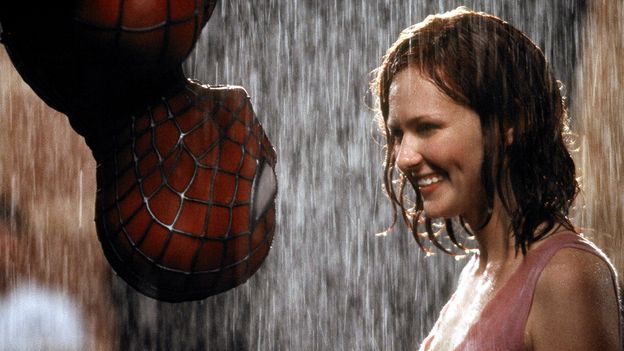
Entire articles could be devoted to Kirsten Dunst’s MTV Award-winning upside-down kiss between Maguire and Mary Jane, but in short, it’s both iconic and epitomizes the film’s old-school romance: it Also noteworthy is that Parker’s storytelling is as much about Mary Jane as the life he leads as Spider-Man. In Raimi’s design, this Mary Jane (stepping into the shoes of canonical first girlfriend Gwen Stacy, whom Dunst initially thought she was chosen for), is a simpler, more down-to-earth version of his character in the comics: the archetypal girl next door, but also someone with insecurities, family struggles, and financial issues that play out onscreen.
Mary Jane is also something like Lois Lane from Spider-Man’s Superman – someone who, as a result of being in constant danger, begins a romantic relationship with the mysterious symbol in front of the man himself, further strengthening the estrangement that Peter feels between these two parts. of his life. This tension between his two selves, the shy geek and the Amazing Spider-Man, the teenage love interest and action hero, his growing pains and that oft-mentioned responsibility, all lead to one of the most blockbuster endings ever. miserable people of his time – one where even when the hero saves the day, he still loses. Because while Mary Jane declares her love to Parker, he feels obliged to reject her in order to protect her from her perilous double life, of which she is still unaware of the existence. It’s an ending that’s quintessential Spider-Man, and one that also completes the film in a way that crucially allows it to stand on its own – something that feels particularly rare as of our days seemingly every superhero movie requires homework and must have an ending – trolling character credit cameos from other upcoming movies.
An intoxicating mix of genres
Above all, it’s Raimi’s skill at handling diverse genres and tones that makes the film such a rich tapestry. Empire associate editor Amon Warmann agrees: “My favorite superhero movies are often the ones with great tonal balance, and Spider-Man achieves that masterfully,” he says. “There’s a lot of funny humor and purely entertaining heroism, but when the movie gets serious, those moments hit just as hard.”
Indeed, there are so many disparate elements in Spider-Man that shouldn’t make sense when mixed together, but work perfectly: Raimi’s aforementioned horror roots revealing themselves after the fatal spider bite Peter’s radiation look like a huge contrast to the absurd comedy of wrestler “Macho Man” Randy Savage’s appearance as “Bonesaw McGraw” in the formative cage match that solidifies Spider-Man’s identity. As Hunt says, “Raimi was the only director who really understood that Spider-Man is both a romance, a comedy, a horror, a sci-fi and an action franchise, and he shot it like if it was all those things with a consistency that we haven’t seen since.”